
UCCE personnel have been evaluating new almond varieties for decades. Several of these efforts have been trials comparing experimental varieties or advanced selections against industry standards. To date, there have been four variety trials funded by the Almond Board of California, two of which are in the ground today. This report details results from the third trial.
The third-generation variety trial was planted at three sites down the Central Valley in winter 2014 at the Chico State Farm in Butte County, a commercial orchard near Salida in Stanislaus County and in a commercial orchard near Chowchilla in Madera County. The three trial sites have different tree spacing and rootstocks (Table 1). There have been no observations of rootstock incompatibility at any of the sites.
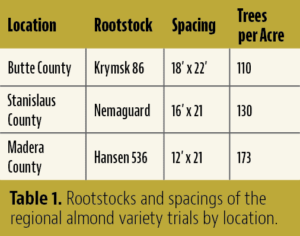
The trials were designed to allow statistical analyses of yield; each variety is planted in 12-tree stretches (11 in Salida) and repeated four times. In total, each site had 44 to 48 trees of each variety, split up into groups of four and randomly arranged within the trial, and bordered by Nonpareil rows.
The varieties under evaluation are listed in Table 2. Many are traditional, self-sterile varieties that require a pollinizer variety to set a commercial crop; however, about one-third are partially or fully self-fertile.
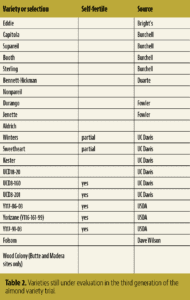
There are some limitations in interpreting the results in these trials aside from the small representative number of trees per variety. To avoid driving our cooperators insane, growers farmed the orchards based on the main variety (Nonpareil). This means that bloom sprays, hullsplit sprays, irrigation/fertilization rates and harvest timing may not have been ideal for each experimental variety. Because there are many varieties present, these trials do not fully evaluate how self-fertile varieties will do when planted on their own, though the breeders have tested for self-fertility. Varieties of small stature are starting to be shaded out by larger, adjacent Nonpareil trees, which may artificially deflate their yield. Acknowledging these limitations, we have been able to gather valuable information on early yields, kernel quality and insect and disease susceptibility as well as other attributes.
As of the 10th leaf (and eight harvests), we have eliminated nine varieties due to poor yields, poor kernel quality and/or poor harvestability, which we defined as the number of nuts left per tree after harvest.
One cultivar from this trial has been released so far: Yorizane. Another highly promising, self-fertile variety from the USDA, Y117-91-03, will hopefully be available to nurseries by fall 2025.
Bloom
Bloom evaluations ended after 2022. Full bloom dates of most varieties were similar to Nonpareil (Table 3). While the bloom dates of all varieties are included in the same table, we stress overlap is not important for self-fertile varieties, and inclusion is simply to convey when typical bloom time occurs.
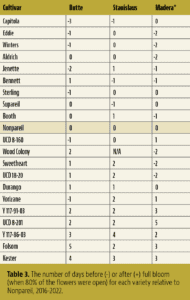
Hullsplit
Unlike bloom, there is a wide variation among varieties in hullsplit dates and the length of time a cultivar spends in hullsplit. We defined a variety as starting hullsplit when approximately 1% of the nuts had an open suture (which is when the first NOW spray should occur), and hullsplit ending when all the nuts on a tree had open sutures. This is the earliest point a variety would be harvested. Rootstock influences hullsplit timing and the length of time it takes for a cultivar to complete hullsplit; the relatively long hullsplit durations at the Madera location are likely due to the trees being planted on the high-vigor Hansen 536.
Yields
Nonpareil has been the top-yielding variety in the Butte and Madera County trials and the sixth highest in Stanislaus (Table 4). While a self-fertile variety with Nonpareil kernel quality, high yields and relatively low disease susceptibility is the almond breeder’s holy grail, it is remarkable to see just how good Nonpareil is. 100+ years of breeding efforts still haven’t been able to do better than random chance (sorry, almond breeders).
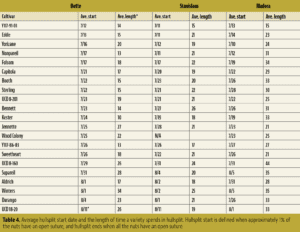
We also evaluate light interception, or photosynthetically active radiation (PAR), which is the percentage of the ground shaded by the canopy. Another way to think about PAR is canopy size. While there are some trees with skinny profiles like Aldrich, in general trees that have a higher PAR are larger trees. Research done by Lampinen et al. (2012) showed every percentage of light intercepted by an almond canopy resulted in an average of 50 lbs. of yield. However, this relationship was generated predominantly using Nonpareil data, and this trial shows the 50 lbs. per % light intercepted isn’t true for all varieties. In this trial, we can look at a measurement called “yield efficiency,” which is essentially looking at how many pounds of nuts are produced per percentage of light intercepted. Again, small varieties may be negatively influenced by the larger Nonpareil tree on either side. However, it does reveal large-canopied varieties that yield relatively poorly, like Supareil, Folsom and Sterling. It also shows some cultivars that have low cumulative yields in comparison to Nonpareil actually do pretty well for the amount of real estate they use; UCD 8-160 and Yorizane actually beat Nonpareil in terms of yield efficiency and may shine more in a field where they aren’t being shaded by larger neighbors.
While Nonpareil has proven to be a high yielder in these trials (Table 5), there are some other varieties that have also done very well. Unfortunately, two of them, Booth and UCD 18-20, have high rates of doubles. It is fairly common to have double percentages higher than 20% for both cultivars.
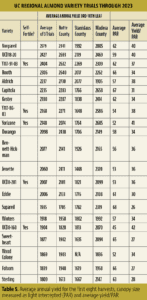
Yorizane is the first variety to be released from these regional trials. It is self-fertile, has excellent kernel quality and has shown few insect or disease problems, although we have seen an undefined staining on the kernel pellicle in some years. The Yorizane tree is smaller than a Nonpareil but has shown to be one of the most yield-efficient varieties in the trials. Yorizane blooms and harvests about the same time as Nonpareil and shakes very well. Because this variety was developed by USDA, it is available from all nurseries with no proprietary fees.
Kester has yielded well and has exhibited few problems. However, it blooms too late to be a good Nonpareil pollinizer and harvests too early to be harvested with Butte, so it is difficult to see how this variety fits.
Y117-91-03 has consistently been one of the highest-yielding varieties in these trials and has excellent kernel quality, although it is smaller than Nonpareil. It shakes well, has had very few insect or disease problems, and harvests before Nonpareil. This promising selection is currently being processed by Foundation Plant Services at UC Davis to create budwood that is certified to be free of viruses and will hopefully be released to nurseries soon.
To see more in-depth information on yields, visit sjvtandv.com. To see the latest annual report, including quality data and the statistical breakdown of yields, light interception and more, see: fruitsandnuts.ucdavis.edu.
Thank you to the Almond Board of California for funding this trial, and to Creekside Farming Company, Salida Unified School District and California State University, Chico for hosting these trials.















